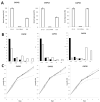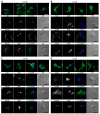Novel Cytoskeleton-Associated Proteins in Trypanosoma brucei Are Essential for Cell Morphogenesis and Cytokinesis
- PMID: 34835360
- PMCID: PMC8625193
- DOI: 10.3390/microorganisms9112234
Novel Cytoskeleton-Associated Proteins in Trypanosoma brucei Are Essential for Cell Morphogenesis and Cytokinesis
Abstract
Trypanosome brucei, the causative agent of African sleeping sickness, harbours a highly ordered, subpellicular microtubule cytoskeleton that defines many aspects of morphology, motility and virulence. This array of microtubules is associated with a large number of proteins involved in its regulation. Employing proximity-dependent biotinylation assay (BioID) using the well characterised cytoskeleton-associated protein CAP5.5 as a probe, we identified CAP50 (Tb927.11.2610). This protein colocalises with the subpellicular cytoskeleton microtubules but not with the flagellum. Depletion by RNAi results in defects in cytokinesis, morphology and partial disorganisation of microtubule arrays. Published proteomics data indicate a possible association of CAP50 with two other, yet uncharacterised, cytoskeletal proteins, CAP52 (Tb927.6.5070) and CAP42 (Tb927.4.1300), which were therefore included in our analysis. We show that their depletion causes phenotypes similar to those described for CAP50 and that they are essential for cellular integrity.
Keywords: BioID; Trypanosoma brucei; cytoskeleton; mass spectrometry; microtubules.
Conflict of interest statement
The authors declare no conflict of interest.
Figures





Similar articles
-
KLIF-associated cytoskeletal proteins in Trypanosoma brucei regulate cytokinesis by promoting cleavage furrow positioning and ingression.J Biol Chem. 2022 Jun;298(6):101943. doi: 10.1016/j.jbc.2022.101943. Epub 2022 Apr 18. J Biol Chem. 2022. PMID: 35447115 Free PMC article.
-
Cell morphogenesis of Trypanosoma brucei requires the paralogous, differentially expressed calpain-related proteins CAP5.5 and CAP5.5V.Protist. 2009 Nov;160(4):576-90. doi: 10.1016/j.protis.2009.05.003. Epub 2009 Aug 4. Protist. 2009. PMID: 19656721
-
The Trypanosoma brucei subpellicular microtubule array is organized into functionally discrete subdomains defined by microtubule associated proteins.PLoS Pathog. 2021 May 19;17(5):e1009588. doi: 10.1371/journal.ppat.1009588. eCollection 2021 May. PLoS Pathog. 2021. PMID: 34010336 Free PMC article.
-
Proteomics and the Trypanosoma brucei cytoskeleton: advances and opportunities.Parasitology. 2012 Aug;139(9):1168-77. doi: 10.1017/S0031182012000443. Epub 2012 Apr 4. Parasitology. 2012. PMID: 22475638 Review.
-
Host-parasite interactions and trypanosome morphogenesis: a flagellar pocketful of goodies.Curr Opin Microbiol. 2003 Aug;6(4):365-70. doi: 10.1016/s1369-5274(03)00092-4. Curr Opin Microbiol. 2003. PMID: 12941406 Review.
Cited by
-
Kharon Is Crucial for Trypanosoma cruzi Morphology but Does Not Impair In Vitro Infection.Pathogens. 2025 Mar 25;14(4):312. doi: 10.3390/pathogens14040312. Pathogens. 2025. PMID: 40333073 Free PMC article.
-
KLIF-associated cytoskeletal proteins in Trypanosoma brucei regulate cytokinesis by promoting cleavage furrow positioning and ingression.J Biol Chem. 2022 Jun;298(6):101943. doi: 10.1016/j.jbc.2022.101943. Epub 2022 Apr 18. J Biol Chem. 2022. PMID: 35447115 Free PMC article.
-
Paving the Way: Contributions of Big Data to Apicomplexan and Kinetoplastid Research.Front Cell Infect Microbiol. 2022 Jun 6;12:900878. doi: 10.3389/fcimb.2022.900878. eCollection 2022. Front Cell Infect Microbiol. 2022. PMID: 35734575 Free PMC article. Review.
References
LinkOut - more resources
Full Text Sources

